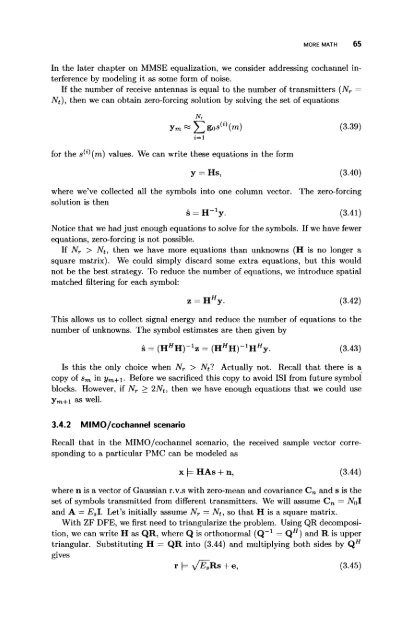mohatta2015.pdf
signal processing from power amplifier operation control point of view
signal processing from power amplifier operation control point of view
Create successful ePaper yourself
Turn your PDF publications into a flip-book with our unique Google optimized e-Paper software.
MORE MATH 65<br />
In the later chapter on MMSE equalization, we consider addressing cochannel interference<br />
by modeling it as some form of noise.<br />
If the number of receive antennas is equal to the number of transmitters (N r —<br />
N t ), then we can obtain zero-forcing solution by solving the set of equations<br />
N,<br />
y m «][>,s (¿) (m) (3-39)<br />
for the s'*) (m) values. We can write these equations in the form<br />
y = Hs, (3.40)<br />
where we've collected all the symbols into one column vector. The zero-forcing<br />
solution is then<br />
β = Η-ν· (3.41)<br />
Notice that we had just enough equations to solve for the symbols. If we have fewer<br />
equations, zero-forcing is not possible.<br />
If N r > N t , then we have more equations than unknowns (H is no longer a<br />
square matrix). We could simply discard some extra equations, but this would<br />
not be the best strategy. To reduce the number of equations, we introduce spatial<br />
matched filtering for each symbol:<br />
z = H H y. (3.42)<br />
This allows us to collect signal energy and reduce the number of equations to the<br />
number of unknowns. The symbol estimates are then given by<br />
s = (Η'Ή)-^ = (Η'ΉΓ'Ην (3.43)<br />
Is this the only choice when JV r > JV t ? Actually not. Recall that there is a<br />
copy of s m in y m +i- Before we sacrificed this copy to avoid ISI from future symbol<br />
blocks. However, if N r > 2N t , then we have enough equations that we could use<br />
y m+ i as well.<br />
3.4.2 MIMO/cochannel scenario<br />
Recall that in the MIMO/cochannel scenario, the received sample vector corresponding<br />
to a particular PMC can be modeled as<br />
x μ HAs + n, (3.44)<br />
where n is a vector of Gaussian r.v.s with zero-mean and covariance C n and s is the<br />
set of symbols transmitted from different transmitters. We will assume C n — N tt I<br />
and A = E S I. Let's initially assume N r = N t , so that H is a square matrix.<br />
With ZF DFE, we first need to triangularize the problem. Using QR decomposition,<br />
we can write H as QR, where Q is orthonormal (Q _1 = Q H ) and R is upper<br />
triangular. Substituting H = QR into (3.44) and multiplying both sides by Q H<br />
gives<br />
r (= v/ËjRs + e, (3.45)



